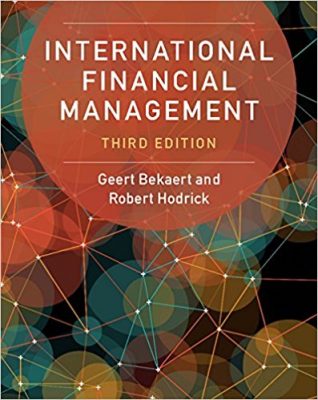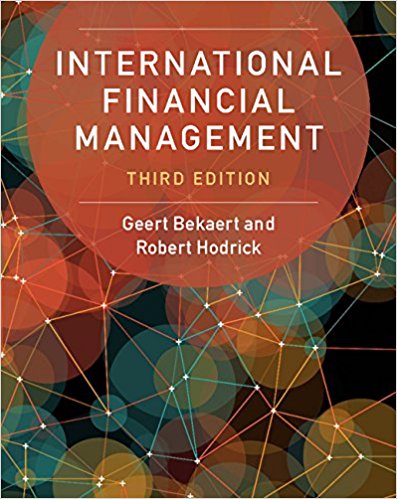 Authors: Geert Bekaert and Robert Hodrick
Authors: Geert Bekaert and Robert Hodrick
Publisher: Cambridge University Press – 1,036 pages
Book Review by: Sonu Chandiram
‘Globalization’ is no longer a term limited to use by people in business, economics, and politics.
It is a real-life, present-day phenomenon that affects your life, those of your neighbors, and all the residents in your country in many ways, including:
- Whether you have a job or not due to foreign competition in manufacturing and trade
- How much money you make from your job or business, and whether it is sustainable
- How far that money goes in buying goods-services essential to your living and enjoyment
- How much you can save and borrow to purchase your first house, and others after that
- How much you can set aside finance your children’s education
- How much it costs to launch your new business, and sustain it for a long period of time
- How much in assets you have available, and how much income you need for retirement
As producers and consumers, it is critical to understand how global competition (or cooperation) affects our lives, and what we can do to equip ourselves with the knowledge and insight needed to live a productive and satisfying life. The good news is that this book provides you that knowledge, along with the insight gained by its authors that is being shared with you.
One of the most important issues we need to understand is: how can one country become price-competitive in different regions of the world with its products and services, so that it can increase its export revenues and profits? This is affected by currency exchange rates, trade promotion programs, as well as interest rates (cost of money) in the regions and countries it exports to.
I believe that we can no longer live in an insular environment, not affected by what happens in other parts of the world. We must be aware of what is going on in other countries, how other people live there and how their political and business leaders are competing for larger shares of the global economic pie. This book will also get you thinking how we can make that pie bigger and better-tasting, with new ideas and their implementation, innovation, and technology.
The authors write in their Preface that the goal of this book is to equip the current and future global business leaders and owners with the tools they need, in order to:
- Understand the issues
- Make sound international financial decisions
- Manage the myriad risks their businesses face in a competitive global environment
There is an immense amount of information in this valuable book, and one way to present its scope of coverage is to provide you an overview of its contents by simply listing the titles of its Parts and chapters. As we have done below:
Preface
- Globalization and the Multinational Corporation
Part I. Introduction to Foreign Exchange Markets and Risks
- The Foreign Exchange Market
- Forward Markets and Transaction Exchange Risk
- The Balance of Payments
- Exchange Rate Systems
Part II. International Parity Conditions and Exchange Rate Determination
- Interest Rate Parity
- Speculation and Risk in the Foreign Exchange Market
- Purchasing Power Parity and Real Exchange Rates
- Measuring and Managing Real Exchange Risk
- Exchange Rate Determination and Forecasting
Part III. International Capital Markets
- International Debt Financing
- International Equity Financing
- International Capital Market Equilibrium
- Country and Political Risk
Part IV. International Corporate Finance
- International Capital Budgeting
- Additional Topics in International Capital Budgeting
- Risk Management and the Foreign Currency Hedging Decision
Part V. Managing Ongoing Operations
- Financing International Trade
- Managing Net Working Capital
Part VI. Foreign Currency Derivatives
- Foreign Currency Futures and Options
- Interest Rate and Foreign Currency Swaps
With a systematic, organized presentation of materials, the authors Geert Bekaert and Robert Hodrick have done a splendid job of explaining how the global financial world works, along with numerous related issues discussed in the chapters, and what needs to be done in each instance, by executives of multinational companies to make their companies gain larger revenues and profits.
Authors:
Geert Bekaert teaches global investments and asset management at Columbia Business School in New York, New York. His research focuses on international finance, emerging markets, empirical asset pricing, and portfolio management. He has been supported with two National Science Foundation (NSF) grants.
He has published over 60 articles in the Journal of Finance, Journal of Political Economy, Journal of Financial Economics, Review of Financial Studies, and other top academic journals. He is Co-Managing Editor at the Journal of Banking and Finance, is a Research Associate at the National Bureau of Economic Research, consults for the European Central Bank and litigation support firms, and is associated with FinTech ventures.
Robert Hodrick teaches international capital markets and corporate finance for MBAs and empirical asset pricing for PhDs at Columbia Business School. His research examines theoretical, empirical, and econometric issues in asset pricing as related to equities, bonds, and currencies and has been supported by NSF grants.
He has published over 40 articles in the Journal of Finance, Journal of Political Economy, Journal of Financial Economics, Review of Financial Studies, and other top economic journals, and is a Research Associate of the National Bureau of Economic Research. He has been a consultant to the International Monetary Fund (IMF) and San Francisco Federal Reserve Bank.







